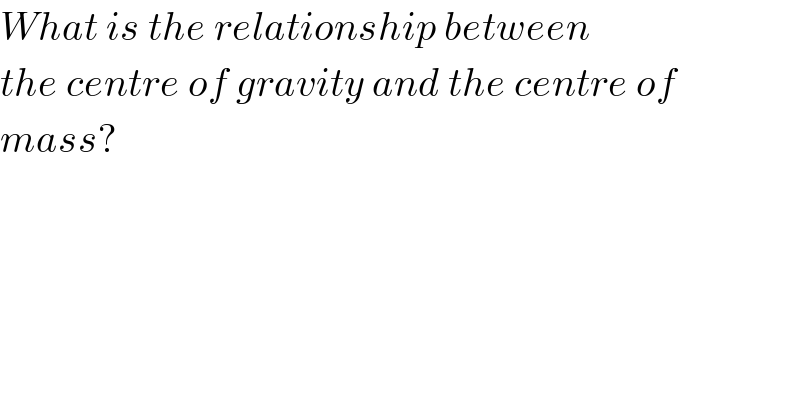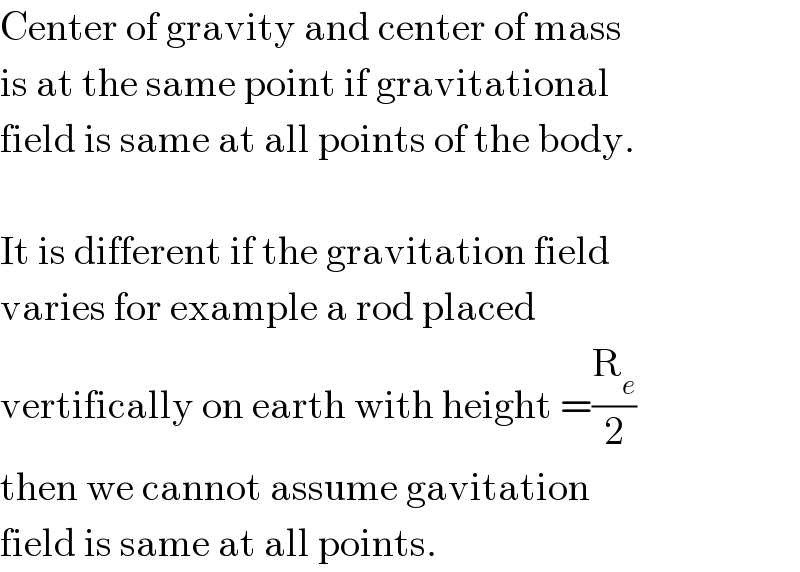
Question and Answers Forum
Question Number 27326 by NECx last updated on 05/Jan/18

Answered by prakash jain last updated on 05/Jan/18

Commented by mrW1 last updated on 06/Jan/18
![I try to calculate. M = mass of earth R = radius of earth m = mass of rod (vertically placed) L = length of rod x_G =position of CoG dm=(m/L)dx F=∫((GMdm)/((R+x)^2 ))=((GMm)/L)∫_0 ^( L) (dx/((R+x)^2 )) =((GMm)/L)[−(1/(R+x))]_0 ^L =((GMm)/L)[(1/R)−(1/(R+L))] =((GMm)/(R(R+L))) F×x_G =∫((xGMdm)/((R+x)^2 ))=((GMm)/L)∫_0 ^( L) ((xdx)/((R+x)^2 )) =((GMm)/L)[(R/(R+x))+ln (R+x)]_0 ^L =((GMm)/L)[(R/(R+L))−1+ln ((R+L)/R)] =((GMm)/L)[−(L/(R+L))+ln ((R+L)/R)] ((GMm)/(R(R+L)))×x_G =((GMm)/L)[−(L/(R+L))+ln ((R+L)/R)] ⇒x_G =((R(R+L))/L)[−(L/(R+L))+ln ((R+L)/R)] ⇒(x_G /L)=((R(R+L))/L^2 )[−(L/(R+L))+ln ((R+L)/R)] let λ=(L/R) or L=λR ⇒(x_G /L)=((R(R+λR))/(λ^2 R^2 ))[−((λR)/(R+λR))+ln ((R+λR)/R)] ⇒(x_G /L)=(((1+λ))/λ^2 )[−(λ/(1+λ))+ln (1+λ)] ⇒(x_G /L)=(((1+λ)ln (1+λ)−λ)/λ^2 )=α ⇒x_G =α L α is not a constant and α<(1/2) ⇒x_G <(L/2) but x_M =(L/2) it means the CoG lies lower than the CoM.](Q27414.png)
Commented by NECx last updated on 05/Jan/18

| ||
Question and Answers Forum | ||
Question Number 27326 by NECx last updated on 05/Jan/18 | ||
 | ||
Answered by prakash jain last updated on 05/Jan/18 | ||
 | ||
| ||
Commented by mrW1 last updated on 06/Jan/18 | ||
![I try to calculate. M = mass of earth R = radius of earth m = mass of rod (vertically placed) L = length of rod x_G =position of CoG dm=(m/L)dx F=∫((GMdm)/((R+x)^2 ))=((GMm)/L)∫_0 ^( L) (dx/((R+x)^2 )) =((GMm)/L)[−(1/(R+x))]_0 ^L =((GMm)/L)[(1/R)−(1/(R+L))] =((GMm)/(R(R+L))) F×x_G =∫((xGMdm)/((R+x)^2 ))=((GMm)/L)∫_0 ^( L) ((xdx)/((R+x)^2 )) =((GMm)/L)[(R/(R+x))+ln (R+x)]_0 ^L =((GMm)/L)[(R/(R+L))−1+ln ((R+L)/R)] =((GMm)/L)[−(L/(R+L))+ln ((R+L)/R)] ((GMm)/(R(R+L)))×x_G =((GMm)/L)[−(L/(R+L))+ln ((R+L)/R)] ⇒x_G =((R(R+L))/L)[−(L/(R+L))+ln ((R+L)/R)] ⇒(x_G /L)=((R(R+L))/L^2 )[−(L/(R+L))+ln ((R+L)/R)] let λ=(L/R) or L=λR ⇒(x_G /L)=((R(R+λR))/(λ^2 R^2 ))[−((λR)/(R+λR))+ln ((R+λR)/R)] ⇒(x_G /L)=(((1+λ))/λ^2 )[−(λ/(1+λ))+ln (1+λ)] ⇒(x_G /L)=(((1+λ)ln (1+λ)−λ)/λ^2 )=α ⇒x_G =α L α is not a constant and α<(1/2) ⇒x_G <(L/2) but x_M =(L/2) it means the CoG lies lower than the CoM.](Q27414.png) | ||
Commented by NECx last updated on 05/Jan/18 | ||
 | ||